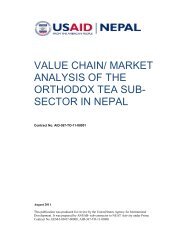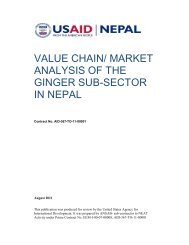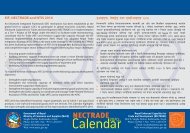value chain/ market analysis of the lentil sub-sector in ... - Nepal Trade
value chain/ market analysis of the lentil sub-sector in ... - Nepal Trade
value chain/ market analysis of the lentil sub-sector in ... - Nepal Trade
Create successful ePaper yourself
Turn your PDF publications into a flip-book with our unique Google optimized e-Paper software.
isen at <strong>the</strong> community level which does help support <strong>the</strong> need that farmers have for credit,<br />
however <strong>the</strong>y are not able to fulfil <strong>the</strong> total credit demand from <strong>the</strong>ir communities due to<br />
weak <strong>in</strong>stitutional management for capital formation and delivery services.<br />
5.1.3 Process<strong>in</strong>g<br />
Unavailability <strong>of</strong> sort<strong>in</strong>g technology for all types <strong>of</strong> weeds at <strong>the</strong> processor level:<br />
Process<strong>in</strong>g consists <strong>of</strong> a number <strong>of</strong> steps <strong>in</strong>clud<strong>in</strong>g mechanical separation, grad<strong>in</strong>g,<br />
decortications, splitt<strong>in</strong>g, and polish<strong>in</strong>g. There are many processors <strong>in</strong> <strong>Nepal</strong> who lack<br />
appropriate facilities that feature sort<strong>in</strong>g technology. This is especially important for sort<strong>in</strong>g<br />
out weeds.<br />
Improper clean<strong>in</strong>g and lack <strong>of</strong> grad<strong>in</strong>g at <strong>the</strong> farmer level: Lentils are very specific <strong>in</strong><br />
terms <strong>of</strong> seed coat color, diameter, thickness, and uniformity <strong>in</strong> appearance. There is no<br />
provision <strong>of</strong> mechanical separation, clean<strong>in</strong>g or grad<strong>in</strong>g <strong>of</strong> <strong>lentil</strong>s at <strong>the</strong> production level<br />
which dim<strong>in</strong>ishes pr<strong>of</strong>its.<br />
5.1.4 Market<strong>in</strong>g<br />
Lack <strong>of</strong> collective <strong>market</strong><strong>in</strong>g at community level: Farmers do not practice collective<br />
<strong>market</strong><strong>in</strong>g at <strong>the</strong> community level for price barga<strong>in</strong><strong>in</strong>g with collectors. Most <strong>of</strong> <strong>the</strong> farmers at<br />
<strong>the</strong> local level do not understand <strong>the</strong> benefits that could be harnessed through collective<br />
<strong>market</strong><strong>in</strong>g.<br />
Lack <strong>of</strong> trade and <strong>market</strong> related <strong>in</strong>formation at <strong>the</strong> producer and trader level: There is<br />
a lack <strong>of</strong> trade and <strong>market</strong> related <strong>in</strong>formation at <strong>the</strong> producer and local traders level<br />
particularly on potential buyers, demand, prices, and quality requirements.<br />
<strong>Trade</strong> is largely dependent upon Bangladesh: Bangladesh is <strong>the</strong> major dest<strong>in</strong>ation <strong>of</strong><br />
<strong>Nepal</strong>ese <strong>lentil</strong> <strong>in</strong>clud<strong>in</strong>g about 83% <strong>of</strong> <strong>Nepal</strong>s total exports <strong>in</strong> 2010.<br />
Lack <strong>of</strong> trust among Bangladeshi banks and <strong>Nepal</strong>ese exporters: There is a poor l<strong>in</strong>kage<br />
between Bangladeshi and <strong>Nepal</strong>ese f<strong>in</strong>ancial <strong>in</strong>stitutions. Bangladeshi f<strong>in</strong>ancial <strong>in</strong>stitutions<br />
are not cooperative with <strong>Nepal</strong>ese exporters and at times as much as six months can go by<br />
before <strong>Nepal</strong>ese exporters receive payments.<br />
Low barga<strong>in</strong><strong>in</strong>g capacity <strong>of</strong> farmers: <strong>Nepal</strong>ese producers are unable to get reasonable price<br />
due to unavailability <strong>of</strong> storage facilities and collection centers. Due to this, farmers are<br />
reluctant to produce <strong>in</strong> large quantities and this is a detriment to <strong>the</strong>ir pr<strong>of</strong>its.<br />
Low purity percentage: 85% purity is regarded as <strong>the</strong> optimum level <strong>in</strong> <strong>the</strong> western part <strong>of</strong><br />
<strong>the</strong> country. About 15% impurity such as weeds, dust, and soil is allowed by western<br />
processor <strong>in</strong> buy<strong>in</strong>g <strong>lentil</strong> while it is 5 percent <strong>in</strong> eastern region which is one <strong>of</strong> <strong>the</strong> major<br />
factors for variation <strong>in</strong> farm gate price between two regions. Grad<strong>in</strong>g and separat<strong>in</strong>g facility<br />
is not available at collectors and farmers level. This impurity level is verified at processor<br />
level dur<strong>in</strong>g procurement <strong>of</strong> <strong>lentil</strong> from collector. If <strong>the</strong>re is more percentage <strong>of</strong> purity,<br />
collectors could get additional price but farmers dont receive purity ga<strong>in</strong>.<br />
Value Cha<strong>in</strong>/ Market Analysis-Lentils 24






